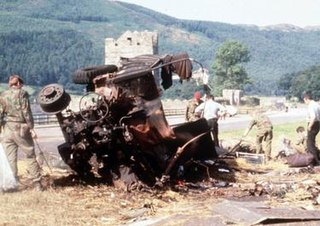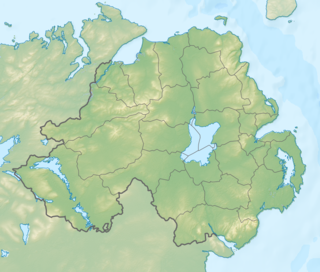
The East Tyrone Brigade of the Provisional Irish Republican Army (IRA), also known as the Tyrone/Monaghan Brigade was one of the most active republican paramilitary groups in Northern Ireland during "the Troubles". It is believed to have drawn its membership from across the eastern side of County Tyrone as well as north County Monaghan and south County Londonderry.

The Irish People's Liberation Organisation was a small Irish republican paramilitary organisation which was formed in 1986 by disaffected and expelled members of the Irish National Liberation Army (INLA) whose factions coalesced in the aftermath of the supergrass trials. It developed a reputation for intra-republican and sectarian violence and criminality, before being forcibly disbanded by the Provisional Irish Republican Army (IRA) in 1992.
This is a chronology of activities by the Provisional Irish Republican Army (IRA) from 1970 to 1979. For actions after this period see Chronology of Provisional Irish Republican Army actions.

The Warrenpoint ambush, also known as the Narrow Water ambush, the Warrenpoint massacre or the Narrow Water massacre, was a guerrilla attack by the Provisional Irish Republican Army (IRA) on 27 August 1979. The IRA's South Armagh Brigade ambushed a British Army convoy with two large roadside bombs at Narrow Water Castle outside Warrenpoint, Northern Ireland. The first bomb was aimed at the convoy itself, and the second targeted the incoming reinforcements and the incident command point (ICP) set up to deal with the incident. IRA volunteers hidden in nearby woodland also allegedly fired on the troops, who returned fire. The castle is on the banks of the Newry River, which marks the border between Northern Ireland and the Republic of Ireland.
The Troubles in Bessbrook recounts incidents during and the effects of the Troubles in Bessbrook, County Armagh, Northern Ireland.
Events during the year 1979 in Northern Ireland.

The Ballygawley bus bombing was a roadside bomb attack by the Provisional Irish Republican Army (IRA) on a bus carrying British soldiers in Northern Ireland. It occurred in the early hours of 20 August 1988 in the townland of Curr near Ballygawley, County Tyrone. The attack killed eight soldiers and wounded another 28. In the wake of the bombing, the British Army began ferrying its troops in and out of County Tyrone by helicopter.
This is a chronology of activities by the Provisional Irish Republican Army (IRA) from 1980 to 1989. For actions before and after this period see Chronology of Provisional Irish Republican Army actions.
The Troubles in Ardoyne lists incidents during the Troubles in the Ardoyne district of Belfast, Northern Ireland.

The Ballygawley land mine attack was a bomb attack carried out by the Provisional Irish Republican Army (IRA) on the 13 July 1983. The IRA exploded a landmine under an Ulster Defense Regiment's (UDR) mobile patrol at Ballygawley Road, near Dungannon in County Tyrone, Northern Ireland. Four UDR soldiers were killed in the incident.

On 11 August 1970, two Royal Ulster Constabulary (RUC) officers were killed by a booby-trap bomb planted under a car by the Provisional Irish Republican Army (IRA) near Crossmaglen, in County Armagh, Northern Ireland. They were the first RUC officers to be killed by republicans during the Troubles and the first security forces to be killed in South Armagh, an IRA stronghold for much of the conflict.

On 9 April 1990 the Provisional IRA (IRA) detonated a massive IED roadside bomb under an Ulster Defence Regiment (UDR) mobile patrol which killed four members of the UDR. It was the worst attack against the UDR since seven years previously when, in July 1983, four soldiers of the same regiment were killed in a similar attack near Ballygawley. It was also one of the worst attacks against the security forces in County Down since the Warrenpoint Ambush of August 1979 when 18 British soldiers were killed and six injured.

The Attack on RUC Birches barracks was an attack on 11 August 1986, the East Tyrone Brigade of the Provisional Irish Republican Army (IRA) attacked the Royal Ulster Constabulary (RUC) base at The Birches near Portadown, in North Armagh Northern Ireland. The unmanned base was first raked with gunfire before being completely destroyed by a 200 pounds (91 kg) bomb, which was driven through the gate of the base in the bucket of a JCB digger.

The Bessbrook landmine attack happened on 19 May 1981 in County Armagh during a period of heightened tension in Northern Ireland's Troubles due to the 1981 Irish hunger strike and the death of Bobby Sands MP on 5 May.

The Killeen Landmine attack took place on the 20 May 1985 when four Royal Ulster Constabulary (RUC) officers were killed when the Provisional IRA exploded an estimated 1,000 pound roadside bomb hidden in a trailer at Killean, County Armagh. The attack occurred just three months after nine RUC officers were killed and 37 injured in the 1985 Newry mortar attack.

On 21 December 1978, three British soldiers were shot dead when the Provisional IRA's South Armagh Brigade ambushed an eight-man British Army foot patrol in Crossmaglen, County Armagh, Northern Ireland.

The Dungannon land mine attack was an Improvised explosive device attack and shooting against a British Army mobile patrol. The attack was carried out by IRA volunteers from the Provisional IRA's East Tyrone Brigade on 16 December 1979, along the Ballygawley Road, just outside Dungannon in County Tyrone. Four British soldiers who were on mobile patrol were killed in the ambush.

On 17 July 1975 the South Armagh Brigade of the Provisional IRA (IRA) detonated a land mine when a British Army foot patrol passed over the land mine, killing four British soldiers and seriously injuring another. This was the first major breach in the truce negotiated by the IRA and British government back in February 1975. The attack took place in Forkhill which was right on the Irish border and a safe haven for IRA Volunteers from South Armagh.
The following is a Timeline of British Amy and Royal Ulster Constabulary (RUC) undercover operations during Operation Banner during the 1969 – 1998 Northern Irish conflict in Northern Ireland that resulted in death or injury. Including operations by the SAS, 14 Intelligence Company, the Military Reaction Force (MRF), RUC Special Patrol Group and Special Branch.




